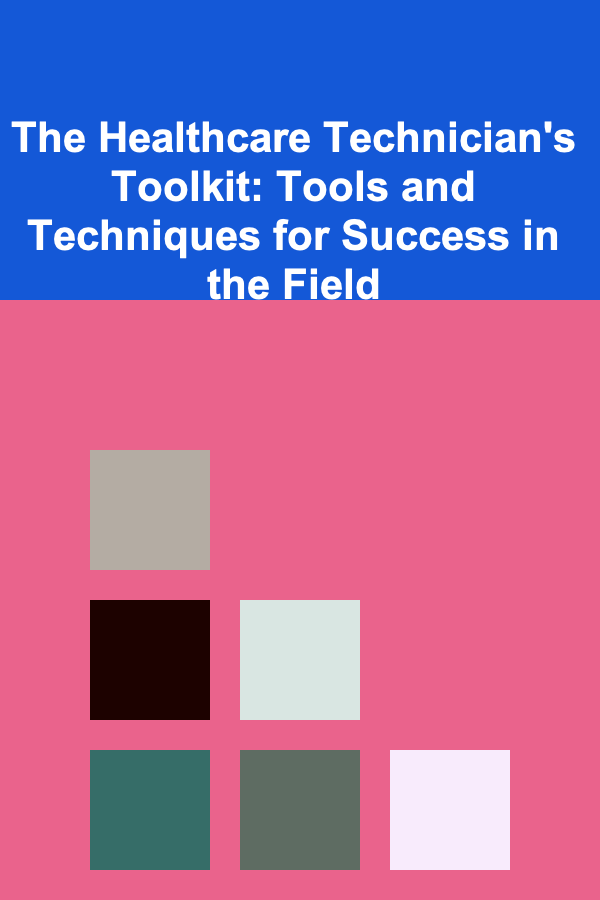
The Healthcare Technician's Toolkit: Tools and Techniques for Success in the Field
ebook include PDF & Audio bundle (Micro Guide)
$12.99$10.99
Limited Time Offer! Order within the next:

Healthcare technicians are the silent heroes of the medical field, providing essential support that ensures smooth operations and optimal patient care. Their roles span across various specialties, including radiology, laboratory sciences, and respiratory therapy, among others. However, regardless of the specific area of practice, healthcare technicians rely on a diverse set of tools and techniques to perform their tasks efficiently and effectively.
In this comprehensive guide, we'll dive deep into the essential tools and techniques that healthcare technicians use to thrive in their respective fields. By understanding and mastering these tools and practices, technicians can deliver high-quality patient care, contribute to seamless medical workflows, and enhance their professional growth.
Mastering Medical Equipment: Essential Tools for Healthcare Technicians
Healthcare technicians interact with a wide variety of medical equipment, from simple diagnostic tools to advanced machinery. Mastering the proper use, maintenance, and troubleshooting of these devices is crucial for ensuring patient safety and accurate results.
1.1 Diagnostic Tools
Diagnostic tools are essential in the healthcare technician's toolkit. They allow for quick, accurate assessments of patient conditions, providing vital information for healthcare providers. Some of the most common diagnostic tools include:
1.1.1 Stethoscope
The stethoscope is a basic yet powerful tool used by many healthcare technicians, especially in roles like respiratory therapy and nursing. It's used to listen to heartbeats, lung sounds, and blood flow. Understanding the subtleties of sound auscultation can help technicians detect abnormal conditions such as arrhythmias or respiratory distress.
- Best Practices for Use: Ensure the earpieces fit comfortably in the ears, and the diaphragm is placed directly on the patient's skin for optimal sound quality. Cleaning the stethoscope regularly helps prevent the spread of infections.
1.1.2 Pulse Oximeter
This device measures the oxygen saturation in the blood, offering valuable insights into a patient's respiratory health. For technicians in respiratory care or intensive care units, pulse oximeters are essential for monitoring patients' oxygen levels, particularly those with respiratory conditions.
- Best Practices for Use: Place the device on the patient's finger or earlobe, ensuring it is snug but not too tight. Regular calibration and sensor maintenance are essential for accuracy.
1.1.3 Electrocardiogram (ECG/EKG) Machine
Used to monitor the electrical activity of the heart, the ECG machine is vital for diagnosing arrhythmias, heart attacks, and other cardiac conditions. Technicians must be well-versed in setting up the machine, applying the electrodes, and interpreting basic readings.
- Best Practices for Use: Proper placement of electrodes is crucial for accurate readings. Regularly calibrating the ECG machine and cleaning the electrodes after use can prevent cross-contamination and improve results.
1.2 Imaging Tools
Medical imaging is one of the most critical areas where technicians are involved, particularly in radiology and ultrasound technology. The ability to operate imaging machines correctly is a key competency.
1.2.1 X-ray Machine
X-ray machines are used to visualize bones and soft tissues, helping diagnose fractures, infections, and certain cancers. Technicians in radiology departments need to ensure the proper positioning of the patient and the correct settings for each specific diagnostic need.
- Best Practices for Use: Minimize radiation exposure by using lead aprons for both patients and technicians. Familiarize yourself with the positioning of patients based on the diagnostic need (e.g., chest, abdomen, extremities).
1.2.2 Ultrasound Machine
Ultrasound technology uses sound waves to produce real-time images of organs and tissues, including in obstetrics, cardiology, and other specialties. Technicians in sonography need to be skilled in operating the ultrasound machine, interpreting the results, and positioning the patient appropriately.
- Best Practices for Use: Use appropriate gel to ensure proper contact between the ultrasound probe and the patient's skin. Maintain a sterile environment and clean the equipment after each use to prevent infections.
1.3 Laboratory Tools
Healthcare technicians in laboratory settings depend on a variety of tools for analyzing samples, performing tests, and ensuring the accuracy of diagnostic results.
1.3.1 Centrifuge
A centrifuge is a device used to separate different components of a liquid sample by spinning it at high speeds. It's particularly important for preparing blood, urine, and other bodily fluids for analysis.
- Best Practices for Use: Ensure the sample tubes are properly balanced in the centrifuge to avoid damage. Follow the manufacturer's instructions for speed and time settings for each type of sample.
1.3.2 Microscopes
Microscopes are indispensable in laboratories for examining cell structures, tissues, and microorganisms. Healthcare technicians in pathology or microbiology labs must know how to operate microscopes effectively and prepare samples for examination.
- Best Practices for Use: Clean the lenses regularly to maintain image clarity. Always store the microscope in a safe, dust-free environment to preserve its integrity.
1.3.3 Autoclave
An autoclave is used for sterilizing medical equipment by using high-pressure steam. It is a crucial tool for preventing infections and ensuring that instruments used in diagnostic tests or procedures are free of contaminants.
- Best Practices for Use: Ensure that the autoclave is properly maintained and calibrated. Regularly inspect seals and pressure gauges to ensure optimal function. Follow sterilization protocols for different types of instruments to ensure effective sterilization.
Techniques for Successful Patient Interactions
A healthcare technician's expertise extends beyond technical skills to include effective patient communication. The ability to make patients feel comfortable, informed, and safe is key to providing high-quality care.
2.1 Proper Patient Positioning
In various fields of healthcare, patient positioning is crucial for obtaining accurate diagnostic results. For instance, in radiology, improper patient positioning can result in unclear X-rays or unnecessary exposure to radiation.
- Best Practices: Always explain the procedure to the patient before positioning them. Ensure that patients are comfortable and that their safety is prioritized. Use pillows or supports to stabilize the patient if necessary.
2.2 Communicating Clearly and Compassionately
Patients may feel anxious, confused, or uncomfortable during medical procedures. As a technician, it's essential to communicate effectively, easing their concerns and fostering a sense of trust.
- Best Practices: Use clear, simple language when explaining procedures. Practice active listening, addressing any concerns patients may have. Reassure patients throughout the process, maintaining a calm and empathetic demeanor.
2.3 Observing and Reporting Patient Conditions
Healthcare technicians must remain vigilant in observing any changes in patient conditions. Whether monitoring vital signs, symptoms, or post-procedure reactions, technicians play a critical role in identifying potential complications.
- Best Practices: Always report any abnormal findings promptly to the appropriate healthcare provider. Document patient conditions accurately and follow protocol for any emergency situations.
Mastering Maintenance and Troubleshooting
The reliability of medical equipment is central to the effectiveness of a healthcare technician's work. Regular maintenance, calibration, and troubleshooting ensure that equipment remains in optimal condition and ready for use.
3.1 Regular Equipment Maintenance
Proactively maintaining medical equipment prevents unexpected breakdowns and prolongs the lifespan of valuable tools. It also ensures that equipment delivers accurate and reliable results.
- Best Practices: Develop a routine for checking, cleaning, and calibrating equipment. Follow the manufacturer's maintenance schedules and keep a log of maintenance activities for reference.
3.2 Troubleshooting Equipment Failures
Occasionally, equipment may fail or produce faulty results. Healthcare technicians must be equipped with troubleshooting skills to diagnose issues before they escalate into bigger problems.
- Best Practices: Understand the common causes of equipment malfunction, such as power issues, calibration errors, or wear and tear. Keep a troubleshooting guide on hand, and know when to escalate issues to a senior technician or manufacturer for more complex repairs.
3.3 Ensuring Safety Protocols
Technicians must follow strict safety protocols when handling medical equipment, particularly when working with radiation or biohazardous materials.
- Best Practices: Always wear the appropriate personal protective equipment (PPE) and follow hospital or facility-specific safety protocols. Be familiar with emergency procedures in case of equipment failure, accidents, or exposure to hazardous materials.
Professional Development and Continuing Education
The healthcare field is dynamic, with new tools, techniques, and technologies emerging regularly. Healthcare technicians must stay up to date on these developments to remain effective and enhance their careers.
4.1 Continuing Education
Participating in ongoing education and training programs helps technicians stay sharp and informed about the latest tools and practices. This could include workshops, certifications, or specialized training in areas such as advanced imaging techniques or laboratory practices.
- Best Practices: Seek opportunities for professional growth through accredited courses. Join professional associations and attend conferences to network with other professionals in the field.
4.2 Seeking Feedback
To continuously improve, healthcare technicians should actively seek feedback from colleagues, supervisors, and patients. Constructive feedback helps technicians identify areas for improvement and refine their skills.
- Best Practices: Regularly request performance reviews and take note of areas where you can improve. Use feedback as an opportunity for growth, and strive to implement changes that will enhance your performance.
Conclusion
The healthcare technician's toolkit is a combination of physical tools and essential techniques that enable professionals to provide the best possible care. By mastering medical equipment, effective patient communication, routine maintenance, and troubleshooting, healthcare technicians can ensure that they perform their roles with precision and confidence. Continuous learning and professional development also ensure that technicians stay at the forefront of their field, adapting to new technologies and methods that improve patient care.
By focusing on these tools and techniques, healthcare technicians can not only thrive in their roles but also make a lasting, positive impact on patient outcomes.
Reading More From Our Other Websites
- [Personal Care Tips 101] How to Choose an Antiperspirant for Active Lifestyles
- [Organization Tip 101] How to Manage Shared Utility Bills Efficiently
- [Personal Finance Management 101] How to Use the Envelope System for Better Budgeting
- [Gardening 101] Organic vs. Synthetic Garden Fertilizer: What's Best for Your Garden?
- [Organization Tip 101] How to Organize Your Music or Movie Collection
- [Home Security 101] How to Set Up a Home Alarm System That Works for You
- [Home Soundproofing 101] How to Soundproof Your Walls Without Removing Drywall
- [Home Renovating 101] How to Update Your Home's Curb Appeal
- [Home Soundproofing 101] How to Soundproof Ceilings from Downstairs Noise
- [Personal Investment 101] How to Understand Cryptocurrency and Start Investing in It

How to Maintain Organized Dresser Drawers
Read More
How to Plan an Eco-Friendly Home Party with Sustainability in Mind
Read More
How to Tackle a Deep Clean Without Feeling Overwhelmed
Read More
How To Prepare Your Garden for Winter
Read More
How To Control Your Data in Online Marketplaces
Read More
Understanding Sacrifice for Redemption: A Deep Dive
Read MoreOther Products

How to Maintain Organized Dresser Drawers
Read More
How to Plan an Eco-Friendly Home Party with Sustainability in Mind
Read More
How to Tackle a Deep Clean Without Feeling Overwhelmed
Read More
How To Prepare Your Garden for Winter
Read More
How To Control Your Data in Online Marketplaces
Read More